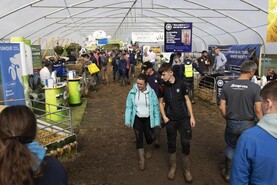EU sheep production fell in the first half of 2018 by 3.5% year-on-year as key producers failed to reach the highs of Easter 2017. According to an outlook report from the European Commission the drop in production is due to difficult weather conditions across the EU, particularly the UK.
In Ireland, a high number of ewes put to the ram and carry-over from 2017 did not lead to an increase in slaughterings.
Across Ireland and the UK, a cold and wet spring followed by a hot, dry summer decreased grass availability and lambing rates, leading to higher mortality rates.
Since 2014, indigenous sheep production in the EU has grown year-on-year, but it is expected to decline from 922 thousand tonnes to 902 thousand tonnes.
Exports
The reduction in production had a knock-on effect on EU sheep exports, which are down 20% for the first half of the year. Key EU exporters such as Spain, Romania, Ireland and the UK have not managed to repeat the growth of last year, especially in March to May.
Drops came in Middle Eastern markets, along with Switzerland and Hong Kong which are now the EU’s top two partners for sheep meat.
The fall in production coupled with competition from Australia is likely to mean exports will stabilise in 2019, despite an increase in world prices.
EU markets have benefitted from the signing of a trade agreement between New Zealand and other Asian-Pacific countries. New Zealand has shifted its exports away from the EU as a result, mainly to China.
Read more
Downward beef price pressure 'to be expected' - EU outlook
EU cereal production 8% below five year average
EU sheep production fell in the first half of 2018 by 3.5% year-on-year as key producers failed to reach the highs of Easter 2017. According to an outlook report from the European Commission the drop in production is due to difficult weather conditions across the EU, particularly the UK.
In Ireland, a high number of ewes put to the ram and carry-over from 2017 did not lead to an increase in slaughterings.
Across Ireland and the UK, a cold and wet spring followed by a hot, dry summer decreased grass availability and lambing rates, leading to higher mortality rates.
Since 2014, indigenous sheep production in the EU has grown year-on-year, but it is expected to decline from 922 thousand tonnes to 902 thousand tonnes.
Exports
The reduction in production had a knock-on effect on EU sheep exports, which are down 20% for the first half of the year. Key EU exporters such as Spain, Romania, Ireland and the UK have not managed to repeat the growth of last year, especially in March to May.
Drops came in Middle Eastern markets, along with Switzerland and Hong Kong which are now the EU’s top two partners for sheep meat.
The fall in production coupled with competition from Australia is likely to mean exports will stabilise in 2019, despite an increase in world prices.
EU markets have benefitted from the signing of a trade agreement between New Zealand and other Asian-Pacific countries. New Zealand has shifted its exports away from the EU as a result, mainly to China.
Read more
Downward beef price pressure 'to be expected' - EU outlook
EU cereal production 8% below five year average






 This is a subscriber-only article
This is a subscriber-only article










SHARING OPTIONS: